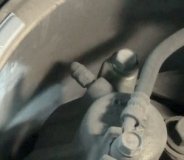Residual check valves are for drum brakes only to keep the lip seals in the wheel cylinders from allowing air to come in when the barometric pressure goes up. You never use them with disc brakes. I've never heard of cleaning a residual check valve. The master cylinder is chosen according to whether the vehicle has drum or disc brakes. You also have to consider the bore size of the pistons in the master cylinder. They were matched to the diameter of the rear wheel cylinders. The pistons in the new rear calipers are much larger in diameter but they must move a lot less to apply the pads. I'm not sure how that equates to the size of the piston in the master cylinder. The few times I've seen people do these modifications, everything comes in a kit that someone else already figured out.
If you're using GM rear calipers with the parking brake built in, (a very miserable design), you can't push the pistons back into the calipers. They require a special tool to screw them in. You might be able to work around that by removing the parking brake lever, turning the actuator screw a little, (not too much), then pushing the piston in, and repeating that until it has gone in enough. When you turn the screw it will sink into the housing. You don't want that to go so far that the seal is exposed and air gets in. Push the piston in, then turn the screw some more.
Once the calipers are installed you have to exercise the parking brake to work the pistons out until the pads contact the rotors otherwise they will never self-adjust and you'll have a mushy pedal.
SPONSORED LINKS
Friday, October 26th, 2012 AT 8:29 PM



